113 Painting Rack 4
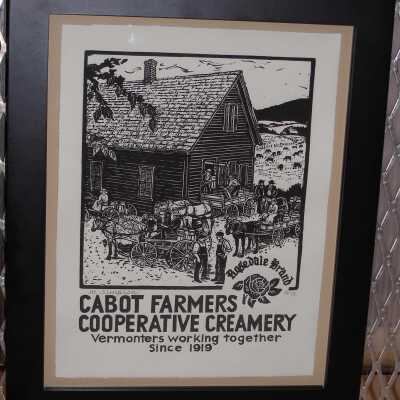

Cabot Farmers Cooperative Creamery
Name/Title
Cabot Farmers Cooperative Creamery
Description
Linocut print. The central focus of the image is a building with slanting (pitched), shingled roof and wooden exterior with shuttered windows surrounded by 4-5 horse-drawn wagons. These wagons are being loaded with milk cans from the open doorway of the building with horses in front of each wagon waiting. Alongside wagons are pairs of farmers. In the back, right is a pair with dark coats and hats and in the front right is another pair in overalls with their sleeves rolled up and bean bag caps. Two women sit atop their wagons, one along the side of the building, by the further window, and one in the lower right hand side facing us. In the background, there are figures of animals grazing peacefully in the fields with a winding fence along the left hand side and a small, barn in the distance with a smaller building attaching to its front facade. Below the image, there is the title, "CABOT FARMERS/ COOPERATIVE CREAMERY" in simplistic, thick, single stroke styled lettering and positioned to the right of it, there is the "Rosedale Brand" logo with gothic-style lettering, which features a rose blossom. Below the title, there is a statement that reads: "Vermonters working together / Since 1919" in stylized, casual, semi-thick semi-thin writing. The print is mounted on light beige paper.
Acquisition
Accession
2009.2
Relationships
Related Person or Organization
Cabot Farmers Co-op, Inc.
Person or Organization
Related Places
Place
Cabot
Town
Washington County
County
Vermont
State/Province
United States of America
Country
North America
Artwork Details
Subject
Cabot Creamery
Made/Created
Artist Information
Simpson, Mary Gorham (b.1945)
Artist
Date made
2008
Dimensions
N/A
Entry/Object ID
2009.2.4
Context
In 1919, the Cabot Village Creamery (built in 1893), incorporated under the co-op model as Cabot Farmers Cooperative Creamery. 94 farms formed the original company which turned their excess milk into butter for the commercial market under the Rosedale name. In 1934, Cabot expanded into cheese production as well. The number of co-op members peaked at approximately 600 Vermont farms in 1960. At this time the company dropped the Rosedale name and marketed cutter and cheese as Cabot.
With the steady decline of dairy farming in Vermont, Cabot merged with Agri-Mark, a co-op representing farmers throughout the northeast, in 1992. Today, Agri-Mark represents about 700 farms in New York and New England. In addition to the Cabot dairy plant, they also operate plants in Massachusetts and New York. Consumer brands include Cabot and McCadam. Bulk whey and dairy protein commercial products are branded as Agri-Mark.
Currently residing in Lyndonville, Mary Gorham Simpson was born in northern Vermont and raised on a working dairy farm in Burke. After graduating from Lyndon State College, she and her husband, Wilder Simpson, taught school in the area for several years, then moved west. They lived for seven years in Wyoming and 14 years in Alaska, returning to Vermont in 1992.
While raising her three children, Simpson took art classes and worked on her own in various media - drawing, calligraphy, and painting. In Alaska, she worked as a graphic artist for the Imaginarium Science Center in Anchorage and as a scenic artist for the Alaska Festival Theater and Anchorage Civic Opera. She did scrimshaw for two shops and exhibit calligraphy for three years for the Anchorage Museum of History and Art.
Now back in Vermont, she mostly works as a printmaker with subjects reflecting memories of Vermont agriculture.
With the steady decline of dairy farming in Vermont, Cabot merged with Agri-Mark, a co-op representing farmers throughout the northeast, in 1992. Today, Agri-Mark represents about 700 farms in New York and New England. In addition to the Cabot dairy plant, they also operate plants in Massachusetts and New York. Consumer brands include Cabot and McCadam. Bulk whey and dairy protein commercial products are branded as Agri-Mark.
Currently residing in Lyndonville, Mary Gorham Simpson was born in northern Vermont and raised on a working dairy farm in Burke. After graduating from Lyndon State College, she and her husband, Wilder Simpson, taught school in the area for several years, then moved west. They lived for seven years in Wyoming and 14 years in Alaska, returning to Vermont in 1992.
While raising her three children, Simpson took art classes and worked on her own in various media - drawing, calligraphy, and painting. In Alaska, she worked as a graphic artist for the Imaginarium Science Center in Anchorage and as a scenic artist for the Alaska Festival Theater and Anchorage Civic Opera. She did scrimshaw for two shops and exhibit calligraphy for three years for the Anchorage Museum of History and Art.
Now back in Vermont, she mostly works as a printmaker with subjects reflecting memories of Vermont agriculture.
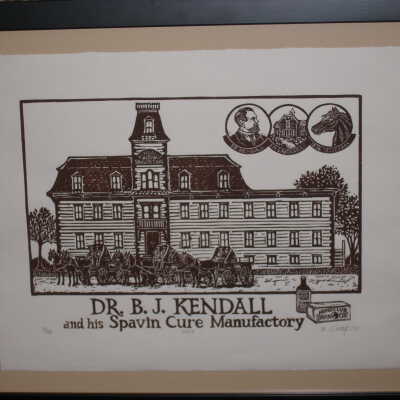

Dr. B.J. Kendall and his Spavin Cure Manufactory
Name/Title
Dr. B.J. Kendall and his Spavin Cure Manufactory
Description
This artwork is a linocut print featuring a central focus on a large building with three stories, a three story, square wing coming out the right hand side, a mansard roof, and a prominent sign that reads "KENDALL'S / 1880 / SPAVIN CURE" in white stick lettering on an arched top sign at the front face of the central tower. Positioned in front of the building are three teams of horses and either buggies or small wagons each facing diagonally towards the left, and each carrying two individuals. In the upper right corner of the print, there are three interlocking circles arranged horizontally. On the left side, there is a profile of a man with groomed hair, coat, and tie facing towards the central circle and the text "DR. KENDALL" below it. Towards the center, there is another, smaller, wooden building with a multisided roof and two side wings with windows, and the text "1st LABORATORY" below it. To the right of the central building, there is a bust of a horse's head also facing towards the central circle with the text "1876 TRADEMARK" below it. The title of the print is located below the image, "DR. B.J. KENDALL" in tall serifed letters with, "and his Spavin Cure Manufactory" underneath in slightly diminuated, serifed lettering. On the right hand side of the title, breaking into the image itself (creating a three dimensional allusion in the exterior blank, white border is another image of a rounded bottle with a thin neck and small, round cap with a label in front, and in front and to the right a box with the front face bearing legible label, "KENDALL'S/SPAVIN CURE" in black boxy lettering with an image of the left facing horse's head in profile within another circular border. Additionally, there are pencil notations on the print, including "10/40," "2006," and "M. Simpson." The print is mounted on light beige paper.
Acquisition
Accession
2009.2
Relationships
Related Person or Organization
Kendall, Burney James (1845-1922), Dr. B. J. Kendall Company
Related Places
Place
Enosburg Falls
Village
Enosburg
Town
Franklin County
County
Vermont
State/Province
United States of America
Country
North America
Artwork Details
Subject Person
Kendall, Burney James (1845-1922)
Made/Created
Artist Information
Simpson, Mary Gorham (b.1945)
Artist
Date made
2006
Dimensions
N/A
Entry/Object ID
2009.2.2
Context
Burney James Kendall grew up in Enosburgh Falls, Vermont and graduated from the Burlington Medical College in 1865. He moved to Minnesota and apprenticed at the practice of Dr. J. C. Mayo. He returned to Enosburgh Falls in 1870 and opened a medical practice and drug store.
He expanded his products to veterinary practice with the introduction of his Spavin Cure for horses. The cure included a healthy dose of opium and did serve to alleviate the pane of swelling of the hocks. Soon he was selling to cure for human consumption as well. The company grew exponentially and a large factory was built in town. His "cures" were marketed and sold throughout the country.
The food and drug act of 1906 put an end to the opium component of the cure, but various versions were sold into the 1920s. Kendall himself became an addict, left the company in the 1880s, and died in 1922.
Currently residing in Lyndonville, Mary Gorham Simpson was born in northern Vermont and raised on a working dairy farm in Burke. After graduating from Lyndon State College, she and her husband, Wilder Simpson, taught school in the area for several years, then moved west. They lived for seven years in Wyoming and 14 years in Alaska, returning to Vermont in 1992.
While raising her three children, Simpson took art classes and worked on her own in various media - drawing, calligraphy, and painting. In Alaska, she worked as a graphic artist for the Imaginarium Science Center in Anchorage and as a scenic artist for the Alaska Festival Theater and Anchorage Civic Opera. She did scrimshaw for two shops and exhibit calligraphy for three years for the Anchorage Museum of History and Art.
Now back in Vermont, she mostly works as a printmaker with subjects reflecting memories of Vermont agriculture.
He expanded his products to veterinary practice with the introduction of his Spavin Cure for horses. The cure included a healthy dose of opium and did serve to alleviate the pane of swelling of the hocks. Soon he was selling to cure for human consumption as well. The company grew exponentially and a large factory was built in town. His "cures" were marketed and sold throughout the country.
The food and drug act of 1906 put an end to the opium component of the cure, but various versions were sold into the 1920s. Kendall himself became an addict, left the company in the 1880s, and died in 1922.
Currently residing in Lyndonville, Mary Gorham Simpson was born in northern Vermont and raised on a working dairy farm in Burke. After graduating from Lyndon State College, she and her husband, Wilder Simpson, taught school in the area for several years, then moved west. They lived for seven years in Wyoming and 14 years in Alaska, returning to Vermont in 1992.
While raising her three children, Simpson took art classes and worked on her own in various media - drawing, calligraphy, and painting. In Alaska, she worked as a graphic artist for the Imaginarium Science Center in Anchorage and as a scenic artist for the Alaska Festival Theater and Anchorage Civic Opera. She did scrimshaw for two shops and exhibit calligraphy for three years for the Anchorage Museum of History and Art.
Now back in Vermont, she mostly works as a printmaker with subjects reflecting memories of Vermont agriculture.
Web Links and URLs
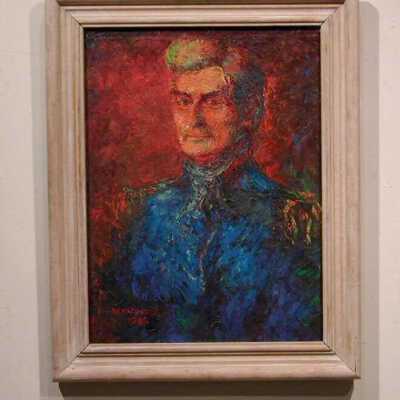

Ethan Allen: An Interpretation
Name/Title
Ethan Allen: An Interpretation
Description
Ethan Allen: An Interpretation
Comtemporary interpretation in reds, oranges, blues and green, heavy textured paint surface, head and background in orange/reds, hair green, clothing in blues and greens. Impressionistic.
Comtemporary interpretation in reds, oranges, blues and green, heavy textured paint surface, head and background in orange/reds, hair green, clothing in blues and greens. Impressionistic.
Acquisition
Source (if not Accessioned)
Unknown
Artwork Details
Medium
Oil
Subject Person
Allen, Ethan (1738-1789)
Made/Created
Artist Information
Tatseos, William George (1915-2002)
Artist
Date made
1948
Dimensions
Width
18 in
Height
24 in
Entry/Object ID
VHS-A-25
Context
No contemporary likeness of Ethan Allen is know, leading to numerous artists trying their hands at their own vision of this famous Vermonter. William Tatseos (1915-2002) created his portrait of Ethan in 1948. This work was reproduced in "Vermont Life" v.2 No.4 Summer 1948.
Web Links and URLs
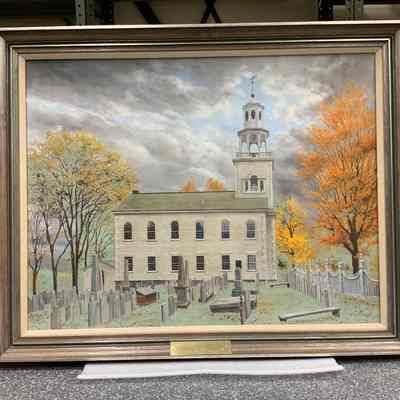

First Church in Territory
Name/Title
First Church in Territory
Type of Painting
Description
Side view of white building with twelve side, multi-paned windows (six per story) with the top row showing rounded top framing and the bottom row completely rectangular. The angling, pitched roof of the building in a light green color. The front facade of the building showing a porch jutting out of the front face itself. From this going upwards is a taller part of the structure (steeple) with a square, white structure with a triform window on the side. The window showing a higher central window with a rounded top and two rectangular side windows. Atop the square part of the tower is a low, latticed fence with tall, white arches in an octagonal shape. Through the fence is a small form (resembling a bell). The octagonal area showing a roof with another, smaller, enclosed octagonal structure on top with ovular, decorated windows on each face and a domed roof. At the center of the roof is a metal vertical structure with a horizontal arrow pointing towards the vanishing point at the center of the painting. Above the central building (the church) are clusters of puffy clouds in varying shades of dark grays. Only around the top of the steeple do the wisping clouds become lighter in shade and a small, speckled patch of light blue sky is showing. Behind the building is another cream-colored building that reaches up to almost halfway of the central church but it appears to sit lower as the profile of a hill is delineating with the foundational dark green, resolute, horizontal line of the main church contrasted with the light, faded green of the foreground arching downwards to the left. This smaller building is facing us with its slanting right green roof carrying off to the right. Flanking the central church on both sides are trees. On the left are five with mostly light, faded green foliage with the center trees showing some mixed yellow and orange leaves on top. On the right hand side are two the tree nearest showing dark, and bright orange foliage and the background tree with bright yellow leaves. Accordingly small groups of bright yellow and orange specks decorating the foreground with fallen leaves. Behind the central church is the top of another tree revealing two rising clusters of dark, bright orange leaves.
In the foreground is a silvery-white, sloping, latticed fence on the right hand side, each section arching upwards and meeting at white, square poles with later-like decorations atop. Mimicking this fencing making perspective lines towards the central building are perfect rows of thin, learning, vertical, stone slabs (headstones). In the second row from the right is one slab lying groundwards instead of standing up and another stacking of thicker slabs on a squarish base. In the central row is a dark gray squarish column narrowing to a point on an ornamented square, multi-layered basin. In the row to the left of the central row is a rectangular, dark brown structure with a gray top slanting downwards facing the fence (sarcophagus style). On the second row in from the left is another rising column in lighter gray with a squared neck and a pointed top. The light, faded green of the ground extends back and beyond the church into the distance to meet something very dark gray.
In the foreground is a silvery-white, sloping, latticed fence on the right hand side, each section arching upwards and meeting at white, square poles with later-like decorations atop. Mimicking this fencing making perspective lines towards the central building are perfect rows of thin, learning, vertical, stone slabs (headstones). In the second row from the right is one slab lying groundwards instead of standing up and another stacking of thicker slabs on a squarish base. In the central row is a dark gray squarish column narrowing to a point on an ornamented square, multi-layered basin. In the row to the left of the central row is a rectangular, dark brown structure with a gray top slanting downwards facing the fence (sarcophagus style). On the second row in from the left is another rising column in lighter gray with a squared neck and a pointed top. The light, faded green of the ground extends back and beyond the church into the distance to meet something very dark gray.
Acquisition
Accession
2023.2
Relationships
Related Publications
Vermont Firsts Collection
Publication
Artwork Details
Medium
Oil
Subject
Old First Church
Made/Created
Artist Information
Mitchell, Bruce Kirk (1933-2018)
Artist
Painter
Role
Date made
1975-1976
Entry/Object ID
2023.2.1
Context
In celebration of the U.S. Bicentennial, the First Vermont Bank commissioned artist Bruce Mitchell to create a series of paintings illustrating "Vermont Firsts." The paintings and the associated catalog were presented at galleries and museums across the state from 1976 to 1978. 16 of the 44 works remained with the bank through mergers and sales, ultimately coming to the Vermont Historical Society as a gift of successor owner TDBank.
This particular painting was gifted by the First Vermont Bank to Senator Leahy and he displayed it prominently in his Washington office until his retirement in 2022. The Senator donated the work to Vermont Historical Society.
The title of this painting is a bit misleading. The first Congregational congregation in the territory that is now Vermont was established in Bennington in 1762 with a meeting house erected in 1766. The current church, as depicted in this painting, was built in 1805 and is one of the oldest continually operating church structures in the state.
This particular painting was gifted by the First Vermont Bank to Senator Leahy and he displayed it prominently in his Washington office until his retirement in 2022. The Senator donated the work to Vermont Historical Society.
The title of this painting is a bit misleading. The first Congregational congregation in the territory that is now Vermont was established in Bennington in 1762 with a meeting house erected in 1766. The current church, as depicted in this painting, was built in 1805 and is one of the oldest continually operating church structures in the state.
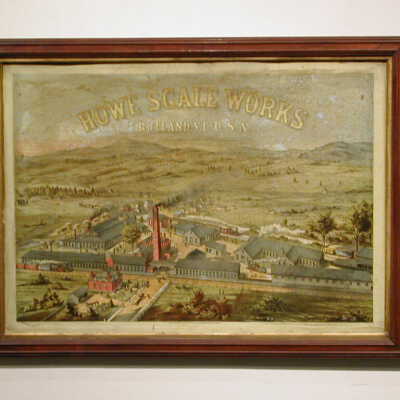

Howe Scale Works
Name/Title
Howe Scale Works
Description
Print on tin showing a bird's eye view of a factory complex. The complex is set within a triangular block and consists of several blue or grey warehouses and a red factory with a tall chimney. The complex is bordered on two sides by railroad tracks, and there is an additional track inside the complex. There is a residential building in the foreground, a small village in the middleground, and grassy hills in the background. The words "HOWE SCALE WORKS / RUTLAND, V.T. U.S.A." are in the sky.
Acquisition
Accession
1984.7
Relationships
Related Person or Organization
Howe Scale, Co. (1857-1982)
Person or Organization
Artwork Details
Medium
Ink, Metal
Subject
Howe Scale Company
Made/Created
Date made
1880-1890
Manufacturer
Kellogg & Bulkeley Company
Dimensions
N/A
Entry/Object ID
1984.7.1
Context
The history of the Howe Scale Company begins with Frank M. Strong of Vergennes and Thomas Ross designing and patenting a ball bearing scale for the Sampson Scale Company of Vergennes. Prior to this invention, the sharp pivot on which the platform of the scale rests would become worn down with repeated use, thus causing the scale to lose accuracy over time. The ball-bearing design provided a shock absorber for the pivot to reduce stress on the scale and improve its accuracy. This was the first major scale improvement in America and the first major innovation by Strong and Ross, the second being the building in 1857 of a gigantic scale for weighing canal boats, a feat that experts said was impossible.
In Spring 1857 John Howe Jr. of Brandon took over Strong and Ross's patents and began to manufacture their designs under the name Howe Scale Company. The Howe Scale Company became world-renowned, earning several awards at fairs and exhibitions, including the the gold, silver, and bronze medals at the 1867 Paris Exhibition against competitors from all over the world.
In 1873 the plant was moved to Rutland, with John A. Mead of Rutland becoming president in 1886, followed by Carl B. Hinsman and Frank G. Riehl. The Howe Scale Company went on to manufacture the weightograph, a device which produces weight readings on a ground glass screen that can be read in the dark from some distance away. It also produced the longest railroad track scale in the world, scales for weighing airplane propellors, and lightweight, aluminum scales that were easily transportable on airplanes. It also began producing trucks and tailers for cargo, and this became an important part of the company's product line. The Howe Scale Company continued to be a leader in the manufactuer of high-accuracy weighing instruments into the twentieth century.
In Spring 1857 John Howe Jr. of Brandon took over Strong and Ross's patents and began to manufacture their designs under the name Howe Scale Company. The Howe Scale Company became world-renowned, earning several awards at fairs and exhibitions, including the the gold, silver, and bronze medals at the 1867 Paris Exhibition against competitors from all over the world.
In 1873 the plant was moved to Rutland, with John A. Mead of Rutland becoming president in 1886, followed by Carl B. Hinsman and Frank G. Riehl. The Howe Scale Company went on to manufacture the weightograph, a device which produces weight readings on a ground glass screen that can be read in the dark from some distance away. It also produced the longest railroad track scale in the world, scales for weighing airplane propellors, and lightweight, aluminum scales that were easily transportable on airplanes. It also began producing trucks and tailers for cargo, and this became an important part of the company's product line. The Howe Scale Company continued to be a leader in the manufactuer of high-accuracy weighing instruments into the twentieth century.
Web Links and URLs
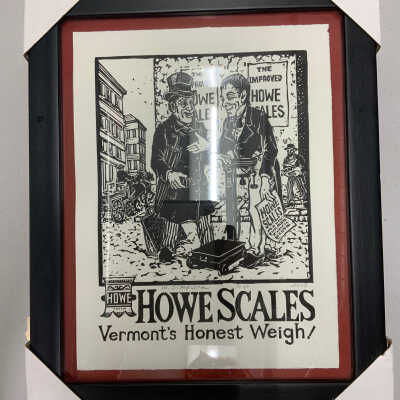

Howe Scales
Name/Title
Howe Scales
Description
Wood block print in black ink on white paper showing a man demonstrating a platform scale on a city street. The salesman is wearing a tailcoat and holding a poster that reads, “HOWE SCALES”. He is gesturing to a man in a top hat who is holding a wallet in one hand and touching the scale with the other. He is standing in striped pants in front of a leaning briefcase on his leg. There are posters for Howe Scales with inscriptions, "THE/IMPROVED/HOWE/SCALES," a man holding a tabletop scale, and a cart toting scales in the background. The bottom of the image is labeled, “HOWE SCALES / Vermont’s Honest Weigh!” with a Howe logo. It is signed in pencil above the label, “M. Simpson 3/40 2010”. The print is top mounted onto dark red mat board and framed behind glass in a black wooden frame.
Acquisition
Accession
2022.21
Relationships
Related Events
Vermont History Expo
Event
Related Person or Organization
Howe Scale, Co. (1857-1982)
Person or Organization
Artwork Details
Medium
Ink
Subject
Howe Scale Company
Made/Created
Artist Information
Simpson, Mary Gorham (b.1945)
Artist
Date made
2010
Dimensions
Width
13 in
Height
16 in
Depth
7/8 in
Entry/Object ID
2022.21.7
Context
The history of the Howe Scale Company begins with Frank M. Strong of Vergennes and Thomas Ross designing and patenting a ball bearing scale for the Sampson Scale Company of Vergennes. Prior to this invention, the sharp pivot on which the platform of the scale rests would become worn down with repeated use, thus causing the scale to lose accuracy over time. The ball-bearing design provided a shock absorber for the pivot to reduce stress on the scale and improve its accuracy. This was the first major scale improvement in America and the first major innovation by Strong and Ross, the second being the building in 1857 of a gigantic scale for weighing canal boats, a feat that experts said was impossible.
In Spring 1857 John Howe Jr. of Brandon took over Strong and Ross's patents and began to manufacture their designs under the name Howe Scale Company. The Howe Scale Company became world-renowned, earning several awards at fairs and exhibitions, including the the gold, silver, and bronze medals at the 1867 Paris Exhibition against competitors from all over the world.
In 1873 the plant was moved to Rutland, with John A. Mead of Rutland becoming president in 1886, followed by Carl B. Hinsman and Frank G. Riehl. The Howe Scale Company went on to manufacture the weightograph, a device which produces weight readings on a ground glass screen that can be read in the dark from some distance away. It also produced the longest railroad track scale in the world, scales for weighing airplane propellors, and lightweight, aluminum scales that were easily transportable on airplanes. It also began producing trucks and tailers for cargo, and this became an important part of the company's product line. The Howe Scale Company continued to be a leader in the manufactuer of high-accuracy weighing instruments into the twentieth century.
Currently residing in Lyndonville, Mary Gorham Simpson was born in northern Vermont and raised on a working dairy farm in Burke. After graduating from Lyndon State College, she and her husband, Wilder Simpson, taught school in the area for several years, then moved west. They lived for seven years in Wyoming and 14 years in Alaska, returning to Vermont in 1992.
While raising her three children, Simpson took art classes and worked on her own in various media - drawing, calligraphy, and painting. In Alaska, she worked as a graphic artist for the Imaginarium Science Center in Anchorage and as a scenic artist for the Alaska Festival Theater and Anchorage Civic Opera. She did scrimshaw for two shops and exhibit calligraphy for three years for the Anchorage Museum of History and Art.
Now back in Vermont, she mostly works as a printmaker with subjects reflecting memories of Vermont agriculture.
In Spring 1857 John Howe Jr. of Brandon took over Strong and Ross's patents and began to manufacture their designs under the name Howe Scale Company. The Howe Scale Company became world-renowned, earning several awards at fairs and exhibitions, including the the gold, silver, and bronze medals at the 1867 Paris Exhibition against competitors from all over the world.
In 1873 the plant was moved to Rutland, with John A. Mead of Rutland becoming president in 1886, followed by Carl B. Hinsman and Frank G. Riehl. The Howe Scale Company went on to manufacture the weightograph, a device which produces weight readings on a ground glass screen that can be read in the dark from some distance away. It also produced the longest railroad track scale in the world, scales for weighing airplane propellors, and lightweight, aluminum scales that were easily transportable on airplanes. It also began producing trucks and tailers for cargo, and this became an important part of the company's product line. The Howe Scale Company continued to be a leader in the manufactuer of high-accuracy weighing instruments into the twentieth century.
Currently residing in Lyndonville, Mary Gorham Simpson was born in northern Vermont and raised on a working dairy farm in Burke. After graduating from Lyndon State College, she and her husband, Wilder Simpson, taught school in the area for several years, then moved west. They lived for seven years in Wyoming and 14 years in Alaska, returning to Vermont in 1992.
While raising her three children, Simpson took art classes and worked on her own in various media - drawing, calligraphy, and painting. In Alaska, she worked as a graphic artist for the Imaginarium Science Center in Anchorage and as a scenic artist for the Alaska Festival Theater and Anchorage Civic Opera. She did scrimshaw for two shops and exhibit calligraphy for three years for the Anchorage Museum of History and Art.
Now back in Vermont, she mostly works as a printmaker with subjects reflecting memories of Vermont agriculture.
Web Links and URLs
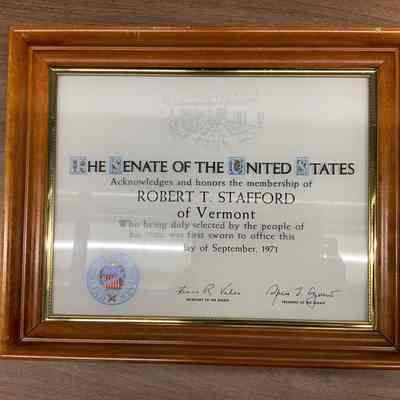

Plaque
Name/Title
Plaque
Description
Framed printed plaque honoring Robert T. Stafford's joining of the United States Senate. The award is printed both on paper within the frame and reverse-printed on the glass. The paper features a watermark image of the Senate Chambers at the top and the lines, "ROBERT T. STAFFORD / of Vermont," "17th day of September, 1971," and the signatures and titles for both Francis R. Valeo, Secretary of the Senate, and Spiro T. Agnew, President of the Senate. There are also gold foil leaf-motif outlines for the first letter of each word "The Senate of the United States" and the red and green backing for the United States Senate seal in the lower left corner. The words, "THE SENATE OF THE UNITED STATES / Acknowledges and honors the membership of," "Who being duly selected by the people of his state was first sworn to office this" before the lines printed on the paper. The plaque resides within a heavy molded wooden frame with bronze interior edging.
Acquisition
Accession
2024.8
Relationships
Related Person or Organization
Stafford, Robert Theodore (1913-2006)
Person or Organization
Dimensions
Width
16 in
Height
13 in
Depth
1-3/4 in
Entry/Object ID
2024.8.1
Context
Robert Theodore Stafford (1913-2006) was an American politician from Vermont. In his lengthy political career, he served as the 71st Governor of Vermont (1959-1961), a United States Representative (1961-1971), and a U.S. Senator (1971-1989). A Republican, Stafford was generally considered a liberal, or "Rockefeller" Republican.
Stafford is best remembered for his staunch environmentalism, his work on higher education, and his support, as an elder statesman, for the 2000 Vermont law legalizing civil unions for same-sex couples.
The Federal Stafford Loan Program for high education is named in his honor.
Stafford is best remembered for his staunch environmentalism, his work on higher education, and his support, as an elder statesman, for the 2000 Vermont law legalizing civil unions for same-sex couples.
The Federal Stafford Loan Program for high education is named in his honor.
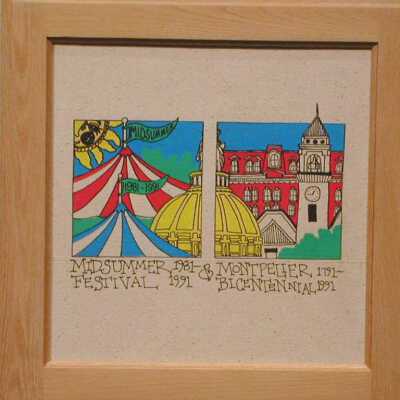

Print
Name/Title
Print
Description
Print on cotton fabric showing striped circus tents in front of Montpelier public buildings. The tents' central poles bear green pennants that read "MIDSUMMER" and "1981-1991". The buildings shown are the dome of the State House, the façade of the Pavilion Building, and the clock tower on City Hall. A smiling sun is at the top left corner. The composition is split into two square panels. The words "MIDSUMMER FESTIVAL / 1981-1991 / & MONTPELIER BICENTENNIAL 1791-1991".
Acquisition
Accession
1991.59
Relationships
Related Events
Midsummer
Event
Related Places
Place
Montpelier
City
Washington County
County
Vermont
State/Province
United States of America
Country
North America
Artwork Details
Made/Created
Artist Information
Burgess, Maureen O'Connor
Artist
Date made
1991
Dimensions
N/A
Entry/Object ID
1991.59.1
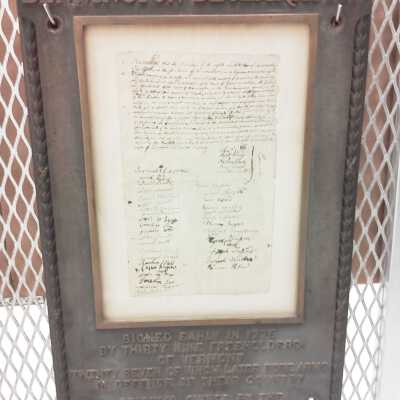

Relic, Historic
Name/Title
Relic, Historic
Description
Photographic reproduction of the Bennington Declaration. Mounted in bronze plaque framed in glass.
Acquisition
Source (if not Accessioned)
Unknown
Dimensions
Width
11-3/8 in
Height
16-5/16 in
Materials
Material
Paper
Entry/Object ID
VHS-A-28
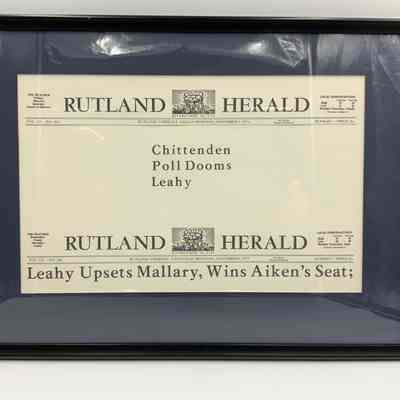

Rutland Herald
Name/Title
Rutland Herald
Description
Framed print showing the upper front page of two Rutland Herald newspapers. The top bears the headline, "Chittenden Poll Dooms Leahy", while the bottom bears the headline, "Leahy Upsets Mallary, Wins Aiken's Seat;".
The upper front page of the newspaper showing "RUTLAND" and "HERALD" in large, black, semi-thin, semi-thick lettering with a central rectangular image. The image has mountains in the background and a large tree in the foreground with a scroll covering the branches with the word "DAILY" in small but stylized lettering. Around the tree are radiating rays and beneath the tree to the left is a small church steeple, and two farmers surrounding a cow, the front farmer kneeling to milk the cow. On the right is another farmer dressed in overalls with a sun hat and carrying on their back a yoke with two objects balanced on either side. Underneath the image bearing inscription, "ESTABLISHED IN 1794." On both headings are the weather, and the temperatures on either side and within a two-lined casing is the volume number, the date, and the price of the journal.
The top heading showing in darker, thicker lettering on the left hand side, "THE WEATHER/Friday:/Showers./Saturday:/Chance of Showers." On the right hand side, "LOCAL TEMPERATURES/Yesterday Year Ago/High 76 54/Low 51 45/Weather Yesterday: Cloudy./(Thursday, October 31). In between the double lines from left to write saying, "VOL. 121 NO. 262. RUTLAND, VERMONT, FRIDAY MORNING, NOVEMBER 1, 1974 90¢ Week/Home Delivered 28 PAGES -- Price 15¢."
The bottom heading showing in darker, thicker lettering on the left hand side, "THE WEATHER/Wednesday:/Cloudy./Thursday:/Cooler." On the right hand side, "LOCAL TEMPERATURES/Yesterday Year Ago/High 58 45/Low 40 26/Weather Yesterday: Rain./(Tuesday, November 5)." In between the double lining borders from left to right, "VOL. 121. NO. 266. RUTLAND, VERMONT, WEDNESDAY MORNING, NOVEMBER 6, 1974 90¢ Week/Home Delivered 28 PAGES Price 15¢."
The upper front page of the newspaper showing "RUTLAND" and "HERALD" in large, black, semi-thin, semi-thick lettering with a central rectangular image. The image has mountains in the background and a large tree in the foreground with a scroll covering the branches with the word "DAILY" in small but stylized lettering. Around the tree are radiating rays and beneath the tree to the left is a small church steeple, and two farmers surrounding a cow, the front farmer kneeling to milk the cow. On the right is another farmer dressed in overalls with a sun hat and carrying on their back a yoke with two objects balanced on either side. Underneath the image bearing inscription, "ESTABLISHED IN 1794." On both headings are the weather, and the temperatures on either side and within a two-lined casing is the volume number, the date, and the price of the journal.
The top heading showing in darker, thicker lettering on the left hand side, "THE WEATHER/Friday:/Showers./Saturday:/Chance of Showers." On the right hand side, "LOCAL TEMPERATURES/Yesterday Year Ago/High 76 54/Low 51 45/Weather Yesterday: Cloudy./(Thursday, October 31). In between the double lines from left to write saying, "VOL. 121 NO. 262. RUTLAND, VERMONT, FRIDAY MORNING, NOVEMBER 1, 1974 90¢ Week/Home Delivered 28 PAGES -- Price 15¢."
The bottom heading showing in darker, thicker lettering on the left hand side, "THE WEATHER/Wednesday:/Cloudy./Thursday:/Cooler." On the right hand side, "LOCAL TEMPERATURES/Yesterday Year Ago/High 58 45/Low 40 26/Weather Yesterday: Rain./(Tuesday, November 5)." In between the double lining borders from left to right, "VOL. 121. NO. 266. RUTLAND, VERMONT, WEDNESDAY MORNING, NOVEMBER 6, 1974 90¢ Week/Home Delivered 28 PAGES Price 15¢."
Acquisition
Accession
2023.9
Relationships
Related Person or Organization
Leahy, Patrick Joseph (b. 1940)
Person or Organization
Related Places
Place
Burlington
City
Chittenden County
County
Vermont
State/Province
United States of America
Country
North America
Dimensions
Width
19-3/4 in
Height
14-3/4 in
Materials
Material
Paper, Wood, Glass
Entry/Object ID
2023.9.1
Context
This print montage of two headlines from the same newspaper hung in Senator Patrick Leahy's Burlington office until his retirement in 2022. Leahy was the first Democratic Senator elected from Vermont since the Civil War and his win was not anticipated. He was ultimately the longest-serving Senator in Vermont History (3rd longest in U.S. history).


Thaddeus Fairbanks tests his new scale + 1830
Name/Title
Thaddeus Fairbanks tests his new scale + 1830
Description
This artwork is a linocut print that portrays a central scene featuring a full hay wagon positioned on a platform scale. To the left of the wagon, there is a team of yoked oxen standing and facing us, while to the right of the wagon, there is a group of seven men and one boy gathered together with waistcoats, tops hats, and canes. All are watching the wagon or facing each other. Adjacent to the oxen, there is a lone man standing nearby his back to us he is holding a prod and wearing boots. He is facing the wagon and the action. In the background, a picturesque country landscape unfolding, showcasing two clusters of buildings. On the right cluster are two medium buildings on a hilltop, perpendicular to each other. On the adjacent hilltop is a tall building next to a long building and two more perpendicular buildings, behind this is rising the pointed spire of a church and behind this s another smaller building with two faces facing us. Another potential square structure lies behind this. On the left cluster are two rectangular, perpendicular buildings, one with a shadowed face towards us and the other all white. In front of this is an "L" shaped building. All over the hill is dappled with shrubbery. Towards the far left, there is a garage or barn structure with four men running out of it. One man in the foreground his legs and arms gesture towards the wagon, one man in the middle with striped pants and suspenders is bending his arms as if running. Two men in the shadow of the doorway outlining in thin white lines showing one aproned man with a tool in hand and the other in a coat. The title of the print is located below the image, "THADDEUS FAIRBANKS" in tall, serif lettering with "test his new scale + 1830" in handwritten style, large, stylistically lowercased lettering and to the right of the title, there is an image of the scale. Additionally, there are pencil notations on the print from left to right, including "Fairbanks 2005," "4/50," and "M. Simpson." On the back dust cover, an information sheet about the inventor is pasted. The print itself is mounted on light beige paper.
Acquisition
Accession
2009.2
Relationships
Related Person or Organization
Fairbanks, Thaddeus (1796-1886), Fairbanks Company
Related Places
Place
St. Johnsbury
Town
Caledonia County
County
Vermont
State/Province
United States of America
Country
North America
Artwork Details
Subject Person
Fairbanks, Thaddeus (1796-1886)
Subject
Fairbanks Scales
Made/Created
Artist Information
Simpson, Mary Gorham (b.1945)
Artist
Date made
2005
Dimensions
N/A
Entry/Object ID
2009.2.3
Context
Thaddeus Fairbanks (1796-1886) was an engineer and inventor who, along with his brother Erastus, developed and sold a large number of mechanical devices from their workshop in St. Johnsbury, Vermont. Around 1830 Thaddeus created the world's first workable platform scale. This invention revolutionized commerce, shipping, and manufacturing. In 1834, he and his brother incorporated the E & T Fairbanks Company to manufacture and sell these scales worldwide. The company expanded with factories in Asia, Africa, and the Carribean as global sales skyrocketed.
The Fairbanks family became very wealthy and founded St. Johnsbury Academy and the Fairbanks Museum and Planetarium. Erastus served two separate terms as Vermont governor and helped found the Republican party.
Fairbanks scales are still produced in St. Johnsbury today.
Currently residing in Lyndonville, Mary Gorham Simpson was born in northern Vermont and raised on a working dairy farm in Burke. After graduating from Lyndon State College, she and her husband, Wilder Simpson, taught school in the area for several years, then moved west. They lived for seven years in Wyoming and 14 years in Alaska, returning to Vermont in 1992.
While raising her three children, Simpson took art classes and worked on her own in various media - drawing, calligraphy, and painting. In Alaska, she worked as a graphic artist for the Imaginarium Science Center in Anchorage and as a scenic artist for the Alaska Festival Theater and Anchorage Civic Opera. She did scrimshaw for two shops and exhibit calligraphy for three years for the Anchorage Museum of History and Art.
Now back in Vermont, she mostly works as a printmaker with subjects reflecting memories of Vermont agriculture.
The Fairbanks family became very wealthy and founded St. Johnsbury Academy and the Fairbanks Museum and Planetarium. Erastus served two separate terms as Vermont governor and helped found the Republican party.
Fairbanks scales are still produced in St. Johnsbury today.
Currently residing in Lyndonville, Mary Gorham Simpson was born in northern Vermont and raised on a working dairy farm in Burke. After graduating from Lyndon State College, she and her husband, Wilder Simpson, taught school in the area for several years, then moved west. They lived for seven years in Wyoming and 14 years in Alaska, returning to Vermont in 1992.
While raising her three children, Simpson took art classes and worked on her own in various media - drawing, calligraphy, and painting. In Alaska, she worked as a graphic artist for the Imaginarium Science Center in Anchorage and as a scenic artist for the Alaska Festival Theater and Anchorage Civic Opera. She did scrimshaw for two shops and exhibit calligraphy for three years for the Anchorage Museum of History and Art.
Now back in Vermont, she mostly works as a printmaker with subjects reflecting memories of Vermont agriculture.
Web Links and URLs


The Discoverer
Name/Title
The Discoverer
Type of Painting
Description
Watercolor painting of "The Discoverer" by Jane Maria Hunt. The painting shows four classically robed female figures: Fortune, Hope, Science, and Faith; and a male figure, Columbus, in black coat and trousers. Columbus stands on a rock jutting into the sea while the four allegories are posed around him. The painting is on artist board, floated within a cream-colored mat, and enclosed in a simple wooden frame.
Acquisition
Accession
2024.6
Relationships
Related Publications
Exploration, Vision & Influence
Publication
Artwork Details
Medium
Watercolor
Subject Person
Columbus, Christopher (1451-1506)
Subject
The Discoverer
Made/Created
Artist Information
Hunt, Jane Maria (1821-1907)
Artist
Date made
1878-1879
Dimensions
N/A
Entry/Object ID
2024.6.9
Context
In 1878 Vermont-born painter William Morris Hunt was commissioned to create two large, allegorical murals for the New York State House in Albany. Completed in 1879, the murals depicted "The Flight of Night" and "The Discoverer." The Flight of Night, utilizing imagery from a Persian poem, was meant to represent barbarism and ignorance leaving the American continent. The Discoverer, featuring Columbus surrounded by classical muses, represented the coming of European enlightenment and culture to America. Shortly after completion, a roof leak severely damaged the murals and permanent drop ceiling was installed that further destroyed the works.
William Morris Hunt, one of the most famous artists of his day, suffered from severe depression and possibly other mental illness. His older sister, Jane Maria Hunt, served as his companion and support during the creation of these murals. A fine artist herself, she created the watercolor of his finished mural you see here. William died by drowning shortly after these murals were completed in a suspect suicide.
William Morris Hunt, one of the most famous artists of his day, suffered from severe depression and possibly other mental illness. His older sister, Jane Maria Hunt, served as his companion and support during the creation of these murals. A fine artist herself, she created the watercolor of his finished mural you see here. William died by drowning shortly after these murals were completed in a suspect suicide.
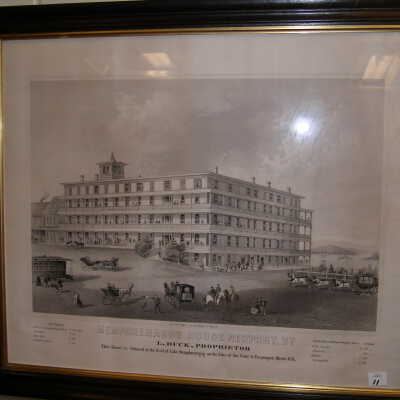

The Memphremagog House
Name/Title
The Memphremagog House
Description
"The Memphremagog House", Newport
Acquisition
Accession
2006.69
Artwork Details
Medium
Ink
Subject
Memphremagog House
Dimensions
Width
27-1/4 in
Height
23-1/4 in
Entry/Object ID
2006.69.3
Context
The Memphremagog House was built in stages over the course of about 40 years. Initially opened in 1830, the hotel reached its full capacity in 1870 with over 300 rooms, running water, steam heat, and gas lighting. For much of the second half of the 19th century, the hotel was a business and tourist anchor for the city of Newport.
The hotel, built immediately on the shore of Lake Memphremagog, had its own rail spur from the south and its own steamship line from the north. Visitors from around the northeast and Canada flocked to Newport in the summer to enjoy the amenities and activities available at the resort.
In 1907, sparks from a passing train, set the hotel on fire. Though valiant efforts of Vermont and Quebec firefighters kept the fire from spreading to the entire city, the hotel was a complete loss. Lieutenant Governor George Prouty helped lead the firefighting and the press relating to his actions that day was said to have propelled him into the Governorship.
The hotel, built immediately on the shore of Lake Memphremagog, had its own rail spur from the south and its own steamship line from the north. Visitors from around the northeast and Canada flocked to Newport in the summer to enjoy the amenities and activities available at the resort.
In 1907, sparks from a passing train, set the hotel on fire. Though valiant efforts of Vermont and Quebec firefighters kept the fire from spreading to the entire city, the hotel was a complete loss. Lieutenant Governor George Prouty helped lead the firefighting and the press relating to his actions that day was said to have propelled him into the Governorship.
Web Links and URLs


Trade Sign
Name/Title
Trade Sign
Description
Rectangular black metal sign with protruding twisting border and the words, "VERMONT MUTUAL FIRE INSURANCE CO" in red with curly cues across the top. The center has a large oval painted with an illustration of a tall, Victorian style brick building with a blue roof, and small Greek cornice style overhangs. Extending vertically upwards from the center of the roof right hand face of the building is a metal flag poll with an American flag (small upper corner in blue with white stars and red and white stripes) blowing to the left. Pedestrians, a car, and a horse-drawn buggy heading towards us surround the building on the ground. The bottom left corner of the side has a round red seal with the Vermont state seal in it surrounded by two laurel branches, and the bottom right corner has an oval seal with the words, "CAPITAL 6,285,000,000". The center bottom says, "MONTPELIER, VERMONT" in bright red, letters with smaller curling ornamentation on the "M" of "MONTPELIER."
Acquisition
Accession
2018.22
Relationships
Related Person or Organization
Vermont Mutual Fire
Person or Organization
Related Places
Place
Montpelier
City
Washington County
County
Vermont
State/Province
United States of America
Country
North America
Made/Created
Date made
1905-1915
Dimensions
Width
20-1/2 in
Height
24-1/4 in
Materials
Material
Metal
Entry/Object ID
2018.22.1
Context
Vermont Mutual was one of the oldest and long-serving insurance companies in Vermont. This headquarters building was constructed in 1870 on the site of company founder's home at what is now 110 State Street in Montpelier. The structure still stands today and is the home of the State's Attorneys association and Sheriffs association.
Web Links and URLs
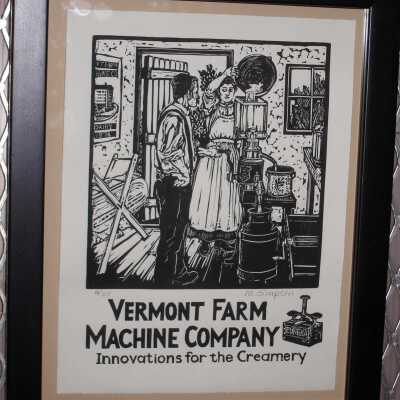

Vermont Farm Machine Company
Name/Title
Vermont Farm Machine Company
Description
This artwork is a linocut print depicting a rural interior scene. In the center of the image in front of an open, multi slatted, wooden door revealing leafy hedges, a woman in a long white apron can be seen pouring milk from a deep bucket into a square, vertical tray of a cream separator bearing a small shield design, while the man standing in profile with dark pants, collared shirt, rolled up sleeves, and a cap is resting his hand on the crank of the separator. The machine is separating into a large (probably tin) milk jug nearer to us and another smaller pot to the right bearing a flora-type design and perching on a square-topped stool. To the right of the couple, there is a swing churn resting along the wall of the room. Positioned above the churn, partially visible on the wall, is a piece of art displaying the text: "VT FARM/ ( ...)HINE CO / [an illustration of a building] / DAIRY / 1878." Along the right hand side of the image there is a four-paned window in the back with a leafy bush, the edge of a textured table and the edge of a rounded, vertical appliance with a rounded-top lid. In the bottom right, slanting towards us is another machine-like object with a central multi-armed horizontal bar attaching to a bent handle of another crank protruding from a rectangular box. Below the image, is the label, "Vermont Farm Machine Company (in large, simplistic lettering) Innovations for the Creamery" (in stylized handwritten-looking irregular lettering). On the left accompanying the tile is a box-like object with a vertically extending handle and two loops protruding on either side with petal-like tops and another horizontal, frontal, handle coming out the front and foreshortened. At the front of the box part of the object is inscription stating, "EUREKA" in stick, white lettering against the black object. The front face showing three white marks on either side like pins. On the left side of the print, there are pencil notations indicating "16/25" and "M. Simpson." The print itself is mounted on light beige paper.
Acquisition
Accession
2009.2
Relationships
Related Events
Vermont History Expo
Event
Related Person or Organization
Vermont Farm Machinery Company (1871-1921)
Person or Organization
Related Places
Place
Bellows Falls
Village
Rockingham
Town
Windham County
County
Vermont
State/Province
United States of America
Country
North America
Artwork Details
Subject
Vermont Farm Machine Company
Made/Created
Artist Information
Simpson, Mary Gorham (b.1945)
Artist
Date made
2008
Dimensions
N/A
Entry/Object ID
2009.2.1
Context
Originally named the Hartford Sorghum Machine Company of Hartford, Connecticut when it started in 1861, the firm manufactured equipment for boiling sap into syrup. In Vermont, that famously means maple syrup. In 1868 they opened a factory in Bellows Falls, Vermont. The Vermont operation was bought out in 1871 and renamed the Vermont Farm Machine Company. They quickly diversified their offerings to dairy processing machinery. Their cream separators and butter churns could be found on farms large and small throughout the country. At one point, it was the largest manufacturer of farm machinery in the world and employed hundreds of workers at its Bellows Falls plant. When raw materials and skilled labor became scarce during WWI, the company fell on hard times and ultimately shuttered its operations in 1921.
Currently residing in Lyndonville, Mary Gorham Simpson was born in northern Vermont and raised on a working dairy farm in Burke. After graduating from Lyndon State College, she and her husband, Wilder Simpson, taught school in the area for several years, then moved west. They lived for seven years in Wyoming and 14 years in Alaska, returning to Vermont in 1992.
While raising her three children, Simpson took art classes and worked on her own in various media - drawing, calligraphy, and painting. In Alaska, she worked as a graphic artist for the Imaginarium Science Center in Anchorage and as a scenic artist for the Alaska Festival Theater and Anchorage Civic Opera. She did scrimshaw for two shops and exhibit calligraphy for three years for the Anchorage Museum of History and Art.
Now back in Vermont, she mostly works as a printmaker with subjects reflecting memories of Vermont agriculture.
Currently residing in Lyndonville, Mary Gorham Simpson was born in northern Vermont and raised on a working dairy farm in Burke. After graduating from Lyndon State College, she and her husband, Wilder Simpson, taught school in the area for several years, then moved west. They lived for seven years in Wyoming and 14 years in Alaska, returning to Vermont in 1992.
While raising her three children, Simpson took art classes and worked on her own in various media - drawing, calligraphy, and painting. In Alaska, she worked as a graphic artist for the Imaginarium Science Center in Anchorage and as a scenic artist for the Alaska Festival Theater and Anchorage Civic Opera. She did scrimshaw for two shops and exhibit calligraphy for three years for the Anchorage Museum of History and Art.
Now back in Vermont, she mostly works as a printmaker with subjects reflecting memories of Vermont agriculture.


Willoughby Lake House
Name/Title
Willoughby Lake House
Description
White, three-story hotel with outbuildings featured in lower right of print. Stage coach can be seen arriving. Two steep mountain peaks frame a lake in the middle and background. The lower left features visitors watching two chained bears fight.
The print is titled: Willoughby Lake House, Westmore, VT
The lithograph is noted as from a "Sketch by Hunter" and produced by "J.H. Bufford's Lith.-Boston."
Instructions for traveling to the resort by rail, stage, or road are printed at the bottom of the piece along with the resort ownership: Bemis, Hall & Company
The print is titled: Willoughby Lake House, Westmore, VT
The lithograph is noted as from a "Sketch by Hunter" and produced by "J.H. Bufford's Lith.-Boston."
Instructions for traveling to the resort by rail, stage, or road are printed at the bottom of the piece along with the resort ownership: Bemis, Hall & Company
Acquisition
Accession
2006.69
Relationships
Related Places
Place
Lake Willoughby
Lake
Westmore
Town
Orleans County
County
Vermont
State/Province
United States of America
Country
North America
Related Publications
Northern Tourist
Publication
Artwork Details
Medium
Paper, Ink
Subject
Willoughby Lake House
Made/Created
Date made
circa 1854
Manufacturer
Bufford's Lithography
Dimensions
Width
25-1/2 in
Height
19-1/2 in
Depth
1 in
Entry/Object ID
2006.69.9
Context
Alonzo Bemis of Lyndon, along with investors, constructed the Willoughby Lake House in 1852. By 1854, when this print was produced, the resort was very popular and growing fast. Summer guests took the Passumpsic Railroad and then the Willoughby Lake and White Mountains Stage Coach operated by resort owners Bemis, Hall & Co. Guests enjoyed boating excursions, guided angling, hikes up mounts Pisgah and Hor, or relaxation on the large lawns. The Lake House was a popular resort and large part of the Westmore economy right up until it was destroyed by fire in 1907. It was never rebuilt and much of the area is now a private campground.